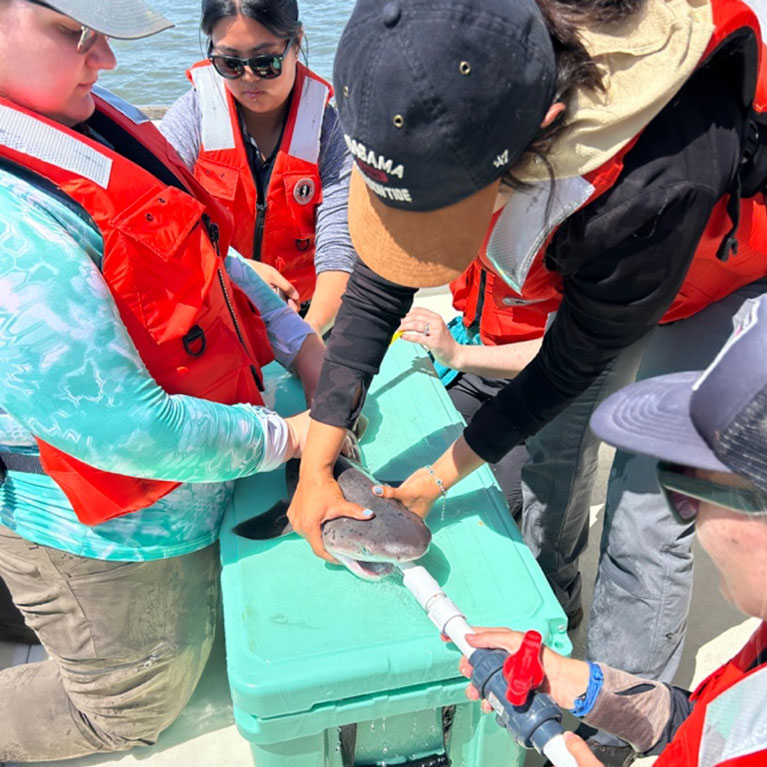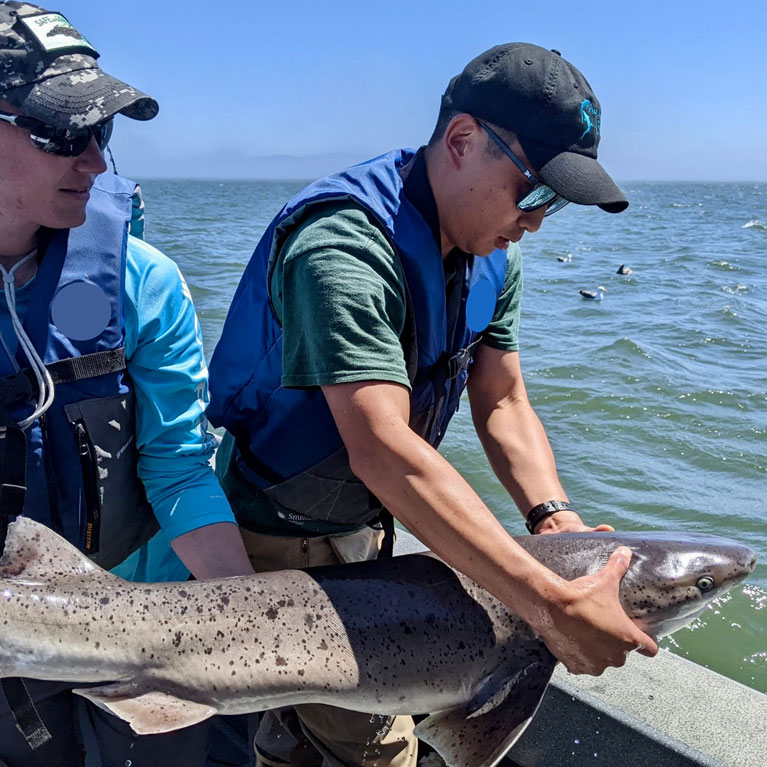Littering lifetimes: understanding the accumulation of pollution in sharks
Kylie is comparing pollution levels in the broadnose sevengill (or cowshark) and the tope shark at a highly impacted site and a pristine site in the San Francisco Bay and Willapa Bay estuaries, respectively. She wants to understand if the contaminants accumulating in shark tissues are matched by the concentration in their environment and explore whether this differs across different age groups and species. Kylie is looking at mercury and per- and polyfluoroalkyl substances, contaminants known to be rife in San Francisco Bay. Sharks use estuaries to mate, pup and grow, so knowing how pollutants affect them across life stages is critical to conservation.
Growing up in the Adirondack Park of north-eastern New York, the largest publicly protected forest reserve in the USA, I have always had a love for outdoor exploration and an appreciation for how important it is to safeguard our natural resources. However, it wasn’t until I started working in a research lab as an undergraduate that I became truly aware of the more subtle negative impacts that human activities have on our environment; impacts that can’t readily be observed by the naked eye, such as chemical pollution. This early engagement in research motivated me to pursue a career...


Does anthropogenic contamination of estuaries impact bioaccumulation in seasonally resident versus transient elasmobranchs?
This project aims to determine whether differences in the pollution of estuaries influence the bio-accumulation of contaminants in broadnose sevengill and tope sharks across life stages. Our objective is to collect air, water and soil as well as blood and muscle samples from sharks caught in estuaries that differ in anthropogenic impact.
The urbanisation of coastal regions has polluted estuarine systems with potentially toxic chemicals. Many sharks use estuaries as mating, pupping and nursery grounds, which makes them acutely vulnerable to coastal pollution during their lifespan. Utilising sharks from an urbanised and a pristine bay, this project will investigate the impact of coastal urbanisation on the contamination of estuaries and bio-accumulation in sharks across all life stages. The data collected are critical to inform efforts to conserve shark populations.
Broadnose sevengill Notorynchus cepedianus and tope Galeorhinus galeus sharks are listed as Vulnerable and Critically Endangered respectively by the IUCN. As benthic predators that roam the oceans, these species are susceptible to direct and indirect anthropogenic stressors, which are magnified by their life history because they spend critical stages in estuaries. Previous studies have demonstrated that differences in habitat use and trophic ecology across species and life stages can influence concentrations of contaminants in sharks, but little is known about the factors that influence bio-accumulation of chemicals in most species, including broadnose sevengill and tope.
San Francisco Bay is the largest estuary on the US west coast and supports a surrounding human population of about eight million people. Studies in this heavily urbanised estuary have found significant levels of toxic chemicals such as mercury and per- and polyfluoroalkyl substances, which are known to bio-accumulate in marine food webs. San Francisco Bay supports abundant populations of broadnose sevengill and tope sharks. Our preliminary data suggest that the bay serves as a pupping and nursery ground for broadnose sevengills, with seasonal residency of adults and year-round residency of younger animals. Adult tope sharks are thought to be seasonal residents, utilising this region for mating.
On the other hand, Willapa Bay, the second largest estuary on the US west coast, has comparatively little human influence. It is estimated to be one of the most pristine bays in North America and supports a seasonal abundance of sub-adult and adult broadnose sevengill and tope sharks.
We will examine differences in chemical concentrations between species; across different life stages within species; within species between the two different estuaries; and in environmental samples from both estuaries. Our results will help to fill important knowledge gaps about the role these coastal ecosystems play in the bio-accumulation of contaminants in broadnose sevengill and tope sharks, two species whose populations are in decline.
- To assess the degree to which coastal human influence contributes to chemical concentrations in San Francisco Bay and Willapa Bay estuaries by collecting and comparing air, water and sediment samples from highly urbanised San Francisco Bay and pristine Willapa Bay monthly over 12 months. These samples will be analysed for concentrations of mercury and per- and polyfluoroalkyl substances, ubiquitous contaminants known to pollute San Francisco Bay.
- To determine whether concentrations of contaminants in the sharks’ tissues correlate with concentrations in their environment and how they are represented across species and age class. We will collect muscle and blood samples from broadnose sevengill and tope sharks in San Francisco Bay and Willapa Bay, which will be analysed for mercury and per- and polyfluoroalkyl substances.
- To analyse the relationship between bio-accumulated toxins and body condition and whether these relationships change across life stages. We will assess body condition using morphometric indices assigned to each stage (neonate, juvenile, sub-adult and adult).

